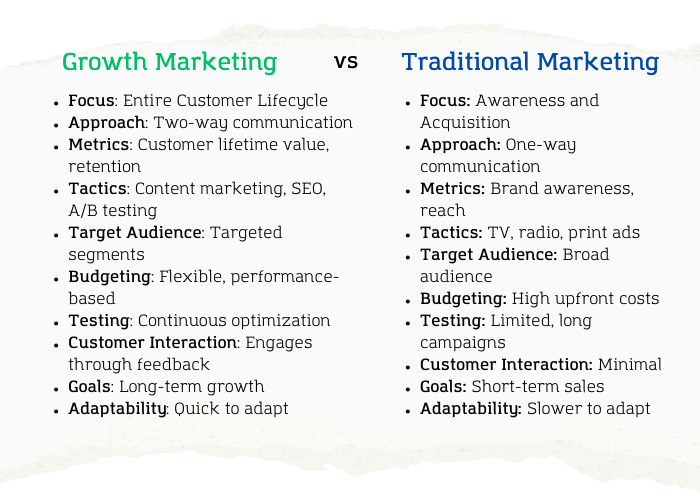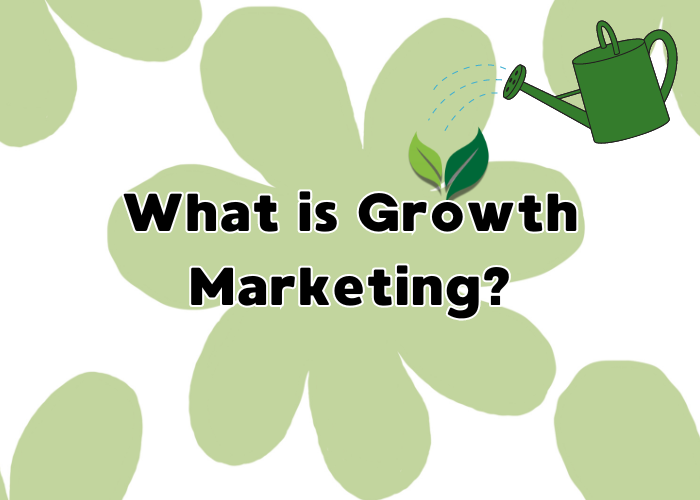Traditional marketing methods no longer suffice to keep brands competitive. Growth marketing takes a more comprehensive approach, focusing not only on acquiring new customers but also on optimizing every stage of the customer journey to drive sustainable growth. By exploring its strategies and understanding how it differs from other marketing approaches, it becomes clear why growth marketing is essential for staying ahead.
What is Growth Marketing?
Growth marketing refers to a data-driven approach focused on optimizing the entire customer funnel, from awareness to retention, and everything in between. It uses creative strategies combined with testing and experimentation to identify what drives sustainable growth. This process leverages both customer insights and real-time data to make informed decisions, ensuring a brand continues to scale efficiently.
Rather than solely focusing on acquisition, growth marketing considers how to enhance every touchpoint of the customer experience, using a mix of marketing channels like SEO, content marketing, paid advertising, and email marketing.
Key Strategies in Growth Marketing
Growth marketing requires a balance of experimentation and proven tactics to deliver measurable results. Here are some key strategies employed:
- A/B Testing: Constant experimentation is at the core of growth marketing. Marketers test variations of content, design, and other factors to see what resonates best with their audience.
- Customer Retention: Growth isn’t just about getting new customers; it’s about keeping them around. Focus on tactics that boost customer loyalty and repeat purchases, such as personalized emails and customer engagement.
- Data-Driven Decisions: Growth marketers rely heavily on analytics. They measure every campaign, track performance, and use that data to refine strategies over time.
- SEO and Content Optimization: Using SEO-driven content to bring organic traffic is another key tactic. Growth marketing isn’t just about short-term gains, but about building long-lasting visibility.
- Conversion Rate Optimization (CRO): Improving the performance of landing pages, checkout flows, or sign-up forms ensures higher conversion rates, turning more visitors into paying customers.
- Viral Loops: Creating a cycle where existing customers refer new customers, encouraging word-of-mouth promotion. Think of referral programs and user-generated content.
On the Marketing topic:
What Does a Marketing Director Do to Drive Brand Success?
How Does Having a Budget Help You Avoid the Traps of Digital Marketing?
The Dynamics of Lifecycle Marketing: A Roadmap to Success
Growth Marketing vs. Traditional Marketing
Traditional marketing is about creating awareness and bringing in leads. Growth marketing, on the other hand, goes beyond just acquisition. It aims for scalability by focusing on retention, customer lifetime value (CLTV), and creating a loyal customer base. Growth marketers care about the entire customer journey, which includes acquisition, activation, retention, referral, and revenue (the AAARRR funnel).
Growth Marketing in Action: An Example
Imagine a new eCommerce platform trying to grow its customer base. Traditional marketing might use tactics like paid ads and influencer partnerships to drive traffic to the website. However, with a growth marketing strategy, the company would not only drive traffic but also focus on retaining users, increasing purchase frequency, and generating referrals.
They might run email marketing campaigns based on past purchase behavior, optimize their checkout process to reduce cart abandonment and use referral programs to incentivize word-of-mouth. Through these efforts, they ensure their customers come back, spend more, and bring in new leads—leading to sustainable growth.
Growth Marketing vs. Performance Marketing
Performance marketing is primarily focused on immediate results like sales, clicks, or conversions through paid advertising. Growth marketing, however, is a holistic approach. While performance marketing often measures short-term goals, growth marketing takes a long-term view and includes retention, loyalty, and lifetime value.
Growth Marketing vs. Digital Marketing
Both growth marketing and digital marketing utilize online channels like social media, SEO, and paid ads. However, digital marketing usually focuses on promoting a brand, while growth marketing is more about experimenting and optimizing to ensure the long-term scalability of a business. Growth marketers are constantly tweaking and testing campaigns to find ways to maximize impact across all stages of the funnel.

Key Metrics to Track in Growth Marketing
Growth marketers are driven by data. Here are a few key metrics they use to measure success:
- Customer Lifetime Value (CLTV): The total revenue a business expects to earn from a customer during their lifetime.
- Customer Acquisition Cost (CAC): How much it costs to acquire a new customer.
- Conversion Rates: The percentage of visitors that take the desired action, such as signing up or making a purchase.
- Churn Rate: The rate at which customers stop using a product or service.
- Retention Rate: How many customers continue to engage with the brand over time?
Key Insights:
Customer-Centric Focus: Growth marketing emphasizes the entire customer journey, not just acquisition. It prioritizes retention, loyalty, and lifetime value, ensuring long-term growth and customer satisfaction.
Data-Driven Experimentation: Unlike traditional marketing, growth marketing relies heavily on continuous testing and data analysis. A/B testing, performance metrics, and customer insights help optimize campaigns for sustainable results.
Holistic Approach: Growth marketing integrates multiple channels—SEO, content marketing, paid ads, and customer engagement—working together to fuel growth across the entire funnel, from awareness to retention.
FAQ Section
What is meant by growth marketing?
Growth marketing refers to a strategic, data-driven approach to increasing a business’s growth by optimizing every stage of the customer journey, from awareness to retention.
What is an example of growth in marketing?
A great example of growth marketing is a SaaS company that uses onboarding emails to guide new users through the platform, helping them achieve success and turning them into loyal customers.
What is growth marketing vs. performance marketing?
While performance marketing is focused on short-term goals like clicks or conversions, growth marketing takes a long-term, holistic approach by focusing on retention, customer loyalty, and sustainable growth.
What is growth marketing vs. digital marketing?
Digital marketing encompasses all online marketing efforts, while growth marketing is a specific approach within digital marketing that uses experimentation and data to optimize growth across the customer lifecycle.
Final Thoughts
Growth marketing is all about taking a long-term view of success. It’s not enough to simply acquire customers; brands need to engage them, retain them, and encourage them to spread the word. Through a combination of data analysis, experimentation, and holistic strategies, growth marketers aim to build scalable businesses that thrive in the digital age.
On the Marketing topic:
What is Field Marketing? Your Brand’s Secret Weapon
What is Green Marketing and How It Can Boost Your Brand?
How to Use Pinterest for Affiliate Marketing in 2024

